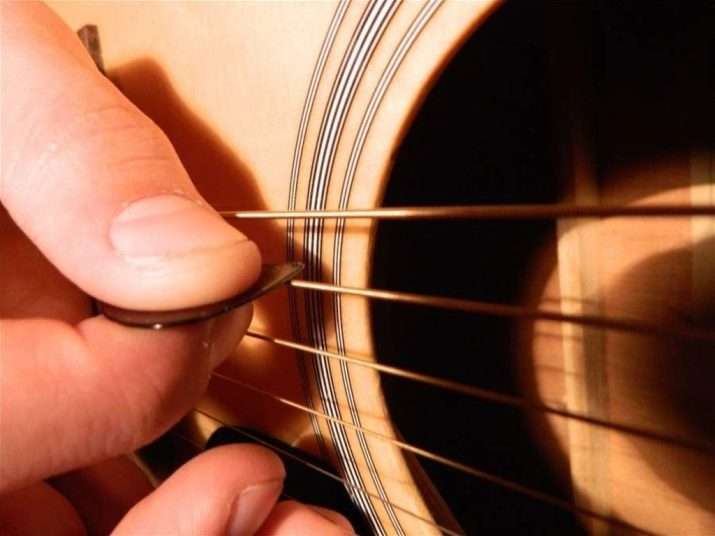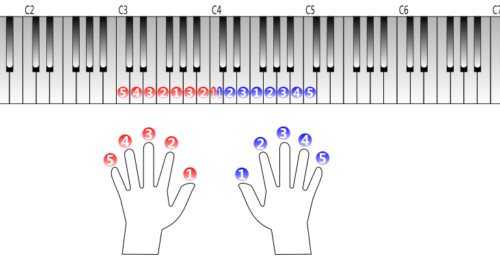
How to play guitar with a mediator?
There are a large number of musical instruments, from which sounds are extracted with a wide variety of objects: wooden sticks, hammers, bows, thimbles, and so on. But when playing acoustic and electric guitars, special plates of a heart-shaped or triangular shape, called “picks”, are used. These small items of an auxiliary accessory for sound production began their history in ancient times when playing many musical stringed instruments in various parts of the globe. But the mediator gained particular popularity with the advent of electric guitars, which is explained by the fact that there is simply no more effective way to play them, except as a mediator.


How to keep?
In more ancient times, the mediator was called a “plectrum”, and it was a bone plate. It was used to play the lyre, zither, cithara. Later, the plectrum was used to extract sounds from the lute, vihuela (the progenitor of the modern guitar) and mandolin. By the end of the 18th century, many stringed instruments, including the guitar, were played with fingers. I must say that the name “plectrum” has survived to this day. Among rock guitarists, the name of the mediator with the word “peak” has taken root.

A modern mediator looks like a small plate, the shape of which can vary greatly. Now the main material for the manufacture of this guitar accessory is plastic and metal, and initially plectrums were created from horns, animal bones, thick leather. Rarely, but still there are sets of tortoise shell picks on sale, which are considered especially valuable among guitarists.
In order for the sound of the strings when playing with a pick to be of high quality, and for it to be securely and comfortably in your hand, you need to learn how to hold it correctly. Of course, most guitarists have their own special grip, but you need to know that there are optimal ways to set up the right hand when picking guitar playing technique, as well as recommended rules for holding the pick with your fingers. This is especially important at the initial level of playing, when the guitarist is just learning how to use the instrument and additional accessories to it.

The plectrum in the form of a triangle is taken by bending the palm of the right hand as if it were necessary to hold the mug by the handle. The plate lies on the lateral surface of the index finger with the center directly on the border of the last and penultimate phalanges, and from above it is pressed with the thumb. At the same time, the sharp (working) end of the mediator is turned to the inner side of the palm at an angle of 90 degrees to the longitudinal line of the hand. As for the rest of the fingers, when taking and finally fixing the mediator, it is better to straighten them so that they do not touch the strings.
It is important not to strain the right hand – it must remain mobile. This allows you to play for a long time without getting tired. However, you should not relax your hand too much, otherwise the mediator will fall out or move. Balance can be found with constant practice. Over time, holding the pick becomes elastic, but also soft at the same time, which allows you to perform even the most difficult passages on the guitar.

Holding the pick when playing an acoustic guitar is not much different from that described above. It is important that the pick does not protrude too much, but at the same time it catches the strings well. This method of holding the plectrum can also be used on a classical guitar, but it is better not to do this – nylon strings will not endure such abuse for long: they will quickly become unusable due to rapid abrasion.
It should be borne in mind that when playing the guitar, only the wrist should work as a pick. The rest of the arm is left at rest so as not to get tired. For the correct position, it is necessary to put the wrist (back) on the body of the instrument above the strings. In this case, the mediator should easily reach each of the six strings. As a rule, the plane of the plectrum is held at some angle with respect to the strings in order to avoid being hit by its tip. They play not with a point, but with the edges of the plate: the strike on the string down is made due to the outer edge of the pick, and the blow from the bottom up is done with the inner edge (closest to the guitarist).

In this position, you can play for a long time and use a variety of techniques. It is advisable to develop a habit and keep your hand in just such a position in order to avoid rapid fatigue of the arm and hand, mistakes, and unnecessary noise.
When playing the bass guitar, the plectrum can be held in exactly the same way as on other types of guitar. The only difference is that the wrist must be held almost still over the strings.

How to learn the game of brute force?
As soon as the hand gets used to taking the pick correctly, you can start practicing various playing techniques. To do this, it is important to find a quiet place where nothing will distract. It should be understood that the first time playing with a pick on the guitar will turn out to be rather clumsy. It will take a large number of exercises and repetitions to bring everything to automatism . You need to tune in to this, without worrying about your abilities ahead of time.

Before learning how to play the guitar by fingering (arpeggio), you first need to learn how to comfortably take a plectrum in your hand, securely fix your wrist and train sound production on individual strings. It is necessary to strike four times with a mediator slowly down, and a little later, with a good result, with an alternating stroke (down-up). These actions must be repeated on each string, starting from the bottom. This exercise should be repeated until everything runs automatically and without errors. As a result, you need to learn how to play by enumeration, that is, to play smoothly and without stopping once on each string, alternately and smoothly moving from one to another. Gradually increase the speed, and for convenience, you can use the metronome.

After successfully fixing this stage, you can connect the left hand. Now you can focus on the melody itself, but at the same time pay attention to the correct extraction of sounds. Another exercise is to strike with a mediator not on each string, but through one. This allows the muscle to remember the location of a particular string, which over time will help the hand to easily find them even with eyes closed.

After mastering the alternate string hook, you can move on to more complex techniques. In order for the brute to come out beautiful, you will have to learn complex combinations of hooks – the previously studied string alternations will help here. Gradually, it is necessary to increase not only the speed, but also the distance. In this case, it is worth starting with simple chords.
You can pick the strings with a pick in the same way as with your fingers, given that there is only one pick. Therefore, it is necessary to constantly maintain a higher speed and precise coordination.
The game with the use of enumerations is required to be mastered by the variable stroke method. It turns out that the subsequent strike on the string should be performed in the other direction. You can not always cling the string only down or only up. For example, if the first string was struck down, then the next one will be struck from the bottom up, then down again, then up. The game should be started by hitting the string down.

When playing by brute force, movements must be made exclusively with a brush. The amplitude should be small, and the hand should feel free. Ideally, it should rest against the body of the guitar for optimal relaxation. It is important to ensure that the sound is smooth and clear, without any interruptions or pauses.
Picking individual strings with a pick is considered more difficult than strumming. With this technique, it will not work to ignore your right hand when playing. It is constantly necessary to observe in what position it is and what the fingers are doing. The plate should not deviate sideways or become parallel to the lines of the strings, not to mention slipping it out of the fingers.
To increase the speed of picking with a plectrum, you can learn a special technique. It lies in the fact that the first string clings from the bottom up, and the next one – from the top down. Further, this sequence is observed on all strings. In this case, fewer movements are made, and the speed of the game increases.

Fighting technique
Fighting with a guitar pick on the strings of a guitar has a great variety of options. For beginners, the simplest up and down strokes are suitable. Gradually, you should increase the speed, fight at a pace only down or only up. In this case, it is necessary to carefully transfer the hand to the working string so that the wrist makes movements in the form of a semicircle. The exercises used must be fixed until the sound is clear, without unnecessary noise, without involuntary muffling, without the mediator falling out of the hand.

Fighting with a pick is almost no different from fighting with your fingers. The only exception is that the plectrum moves up and down without additional “assistants” (there is no division into strikes of the thumb and other fingers of the right hand). All strokes that are known can be easily reproduced with a plate. In this case, the most important thing is to properly hold it.
It is worth trying to strike the strings as naturally as possible. There should not be a feeling that the strings with the plectrum are fighting or there is an obstacle in the way of the plate. In this case, you should take the accessory as close to the edge as possible so that the protruding part is very small. Also, do not hold the pick parallel to the strings.

Among the combat there is a special type called “downstroke”. It differs in that it is necessary to strike only down. This technique requires placing accents in the form of stronger strikes on the strings. This will allow you to maintain the rhythm and better feel the melody.
When playing in combat, it is worth considering that it is necessary to strike not from the shoulder, but from the hand. It is necessary to try to keep unnecessary movements as small as possible. In addition, you should choose an adequate impact force. When playing correctly, the forearm should remain motionless. It is better to practice these skills immediately on the songs.

Fighting techniques are performed with fingers or palm with a little more tension. At first, the pick may pick on extra strings or slow down, but with practice this goes away. When moving your hand down, it is advisable to slightly raise the tip of the plate so that it moves along the strings at an angle. When the brush goes up – the tip of the mediator should change its position to the opposite. You should get a movement in the form of a wave, extracting harmonious sounds.
For more information on how to play the guitar with a pick, see the video below.





